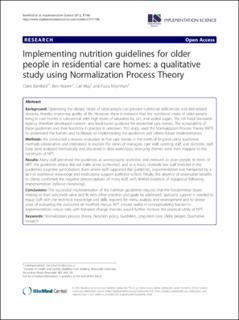| dc.contributor.author | Bamford, C. | |
| dc.contributor.author | Heaven, B. | |
| dc.contributor.author | May, C. | |
| dc.contributor.author | Moynihan, P. | |
| dc.date.accessioned | 2022-11-30T12:41:52Z | |
| dc.date.available | 2022-11-30T12:41:52Z | |
| dc.date.issued | 2012 | |
| dc.identifier.citation | Bamford, C., Heaven, B., May, C. & Moynihan, P. (2012). Implementing nutrition guidelines for older people in residential care homes: a qualitative study using normalization process theory. Implementation Science, 7(1), 1–13. | en_US |
| dc.identifier.uri | https://hdl.handle.net/11250/3035057 | |
| dc.description.abstract | Background
Optimizing the dietary intake of older people can prevent nutritional deficiencies and diet-related diseases, thereby improving quality of life. However, there is evidence that the nutritional intake of older people living in care homes is suboptimal, with high levels of saturated fat, salt, and added sugars. The UK Food Standards Agency therefore developed nutrient- and food-based guidance for residential care homes. The acceptability of these guidelines and their feasibility in practice is unknown. This study used the Normalization Process Theory (NPT) to understand the barriers and facilitators to implementing the guidelines and inform future implementation.
Methods
We conducted a process evaluation in five care homes in the north of England using qualitative methods (observation and interviews) to explore the views of managers, care staff, catering staff, and domestic staff. Data were analyzed thematically and discussed in data workshops; emerging themes were then mapped to the constructs of NPT.
Results
Many staff perceived the guidelines as unnecessarily restrictive and irrelevant to older people. In terms of NPT, the guidelines simply did not make sense (coherence), and as a result, relatively few staff invested in the guidelines (cognitive participation). Even where staff supported the guidelines, implementation was hampered by a lack of nutritional knowledge and institutional support (collective action). Finally, the absence of observable benefits to clients confirmed the negative preconceptions of many staff, with limited evidence of reappraisal following implementation (reflexive monitoring).
Conclusions
The successful implementation of the nutrition guidelines requires that the fundamental issues relating to their perceived value and fit with other priorities and goals be addressed. Specialist support is needed to equip staff with the technical knowledge and skills required for menu analysis and development and to devise ways of evaluating the outcomes of modified menus. NPT proved useful in conceptualizing barriers to implementation; robust links with behavior-change theories would further increase the practical utility of NPT. | en_US |
| dc.publisher | Implementation Science | en_US |
| dc.rights | Navngivelse 4.0 Internasjonal | * |
| dc.rights.uri | http://creativecommons.org/licenses/by/4.0/deed.no | * |
| dc.subject | normalization process theory | en_US |
| dc.subject | nutrition policy | en_US |
| dc.subject | guidelines | en_US |
| dc.subject | long-term care | en_US |
| dc.subject | older people | en_US |
| dc.subject | qualitative research | en_US |
| dc.subject | implementering | en_US |
| dc.subject | veiledere | en_US |
| dc.subject | retningslinjer | en_US |
| dc.title | Implementing nutrition guidelines for older people in residential care homes: a qualitative study using normalization process theory | en_US |
| dc.type | Journal article | en_US |
| dc.source.pagenumber | 1–13 | en_US |
| dc.source.volume | 7 | en_US |
| dc.source.journal | Implementation Science | en_US |
| dc.source.issue | 1 | en_US |
| dc.identifier.doi | https://doi.org/10.1186/1748-5908-7-106 | |

